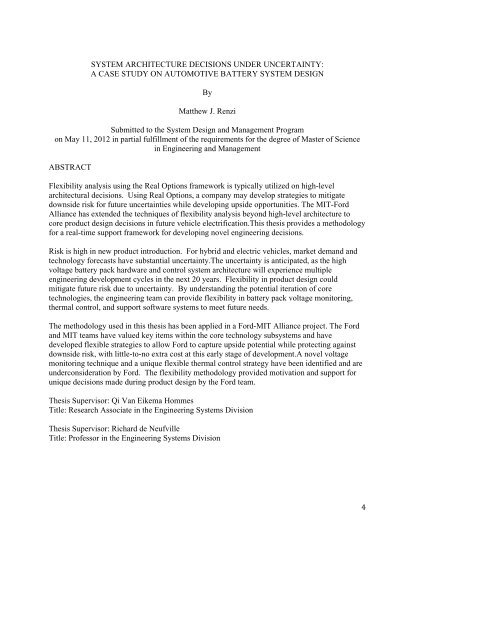A Case Study on Automotive Battery System Design - Title Page - MIT
A Case Study on Automotive Battery System Design - Title Page - MIT
A Case Study on Automotive Battery System Design - Title Page - MIT
- No tags were found...
You also want an ePaper? Increase the reach of your titles
YUMPU automatically turns print PDFs into web optimized ePapers that Google loves.
SYSTEM ARCHITECTURE DECISIONS UNDER UNCERTAINTY:A CASE STUDY ON AUTOMOTIVE BATTERY SYSTEM DESIGNByMatthew J. RenziSubmitted to the <strong>System</strong> <strong>Design</strong> and Management Program<strong>on</strong> May 11, 2012 in partial fulfillment of the requirements for the degree of Master of Sciencein Engineering and ManagementABSTRACTFlexibility analysis using the Real Opti<strong>on</strong>s framework is typically utilized <strong>on</strong> high-levelarchitectural decisi<strong>on</strong>s. Using Real Opti<strong>on</strong>s, a company may develop strategies to mitigatedownside risk for future uncertainties while developing upside opportunities. The <strong>MIT</strong>-FordAlliance has extended the techniques of flexibility analysis bey<strong>on</strong>d high-level architecture tocore product design decisi<strong>on</strong>s in future vehicle electrificati<strong>on</strong>.This thesis provides a methodologyfor a real-time support framework for developing novel engineering decisi<strong>on</strong>s.Risk is high in new product introducti<strong>on</strong>. For hybrid and electric vehicles, market demand andtechnology forecasts have substantial uncertainty.The uncertainty is anticipated, as the highvoltage battery pack hardware and c<strong>on</strong>trol system architecture will experience multipleengineering development cycles in the next 20 years. Flexibility in product design couldmitigate future risk due to uncertainty. By understanding the potential iterati<strong>on</strong> of coretechnologies, the engineering team can provide flexibility in battery pack voltage m<strong>on</strong>itoring,thermal c<strong>on</strong>trol, and support software systems to meet future needs.The methodology used in this thesis has been applied in a Ford-<strong>MIT</strong> Alliance project. The Fordand <strong>MIT</strong> teams have valued key items within the core technology subsystems and havedeveloped flexible strategies to allow Ford to capture upside potential while protecting againstdownside risk, with little-to-no extra cost at this early stage of development.A novel voltagem<strong>on</strong>itoring technique and a unique flexible thermal c<strong>on</strong>trol strategy have been identified and areunderc<strong>on</strong>siderati<strong>on</strong> by Ford. The flexibility methodology provided motivati<strong>on</strong> and support forunique decisi<strong>on</strong>s made during product design by the Ford team.Thesis Supervisor: Qi Van Eikema Hommes<strong>Title</strong>: Research Associate in the Engineering <strong>System</strong>s Divisi<strong>on</strong>Thesis Supervisor: Richard de Neufville<strong>Title</strong>: Professor in the Engineering <strong>System</strong>s Divisi<strong>on</strong>4
















